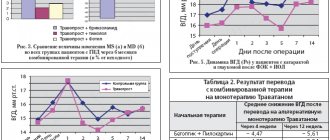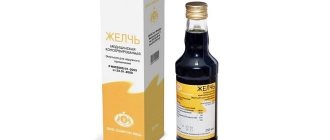Mode of application
Taflotan is usually prescribed 1 drop once a day. With more frequent use, the effectiveness of the medicine decreases.
The dropper tube is used for single use only. Its volume is enough for instillation into both eyes. The dropper tube must be disposed of, even if there is some amount of the drug left in it.
Caution is required when prescribing medication for kidney and liver disease.
To reduce the systemic effect of the drug, after instillation it is necessary to perform nasolacrimal occlusion with a finger.
Taflotan, 30 pcs., 0.3 ml, 0.0015%, eye drops
Tafluprost is a fluorinated analogue of prostaglandin F2α. Tafluprost acid, being its biologically active metabolite, has high activity and selectivity towards the human FP-prostanoid receptor. The affinity of tafluprost acid for the FP receptor is 12 times higher than the affinity of latanoprost. Pharmacodynamic studies in monkeys showed that tafluprost reduces intraocular pressure by increasing uveoscleral outflow of aqueous humor.
Pharmacodynamic effect Experiments on monkeys with normal and elevated intraocular pressure (IOP) demonstrated that Tafluprost is an effective drug for lowering IOP. In a study examining the IOP-lowering effect of tafluprost metabolites, it was found that only tafluprost acid significantly reduced IOP. A study in rabbits treated for 4 weeks with tafluprost ophthalmic solution, 0.0015%, once daily, showed that optic disc blood flow increased significantly (15%) compared to baseline, when measured at 14 and Day 28 using laser speckle flowgraphy.
Clinical effect The reduction in intraocular pressure begins within 2-4 hours after the first installation of the drug, and the maximum effect is achieved after approximately 12 hours. The effect lasts for at least 24 hours. Leading studies on the use of tafluprost, which contains the preservative benzalkonium chloride, have shown that tafluprost is effective as monotherapy and also has an additive effect when used as an additional therapy to timolol. In a 6-month study, tafluprost, at various time points throughout the day, demonstrated a significant IOP-lowering effect: 6 to 8 mmHg. Art., compared with latanoprost, which reduces IOP by 7-9 mm Hg. Art. In another 6-month clinical study, tafluprost reduced IOP by 5-7 mmHg, and timolol by 4-6 mmHg. Art.. The IOP-lowering effect of tafluprost also persisted when the duration of these studies was increased to 12 months. In a 6-week study, the IOP-lowering effect of tafluprost was compared with the effect of its indifferent vehicle when used in combination with timolol. Compared to baseline values (measurements taken after a 4-week course of treatment with timolol), the additional IOP-lowering effect was 5-6 mmHg. in the timolol-tafluprost group and 3-4 mm Hg. in the timolol-differential filler group. In a small crossover study with a 4-week treatment period, preservative-free and preservative-free formulations demonstrated similar IOP-lowering effects of greater than 5 mmHg. In addition, in a 3-month study in the United States, a comparison was made between preservative-free tafluprost and timolol. also without a preservative, it was found that tafluprost reduced IOP by 6.2-7.4 mmHg. at different time points, whereas values for timolol varied between 5.3 and 7.5 mmHg.
Pharmacokinetics Absorption After installation of tafluprost eye drops, 0.0015% in a dropper tube, without preservative, once a day, one drop in both eyes for 8 days, its plasma concentrations were low and had a similar profile on days 1 and 8 . Plasma concentrations peaked 10 minutes after administration and decreased to levels below the lower limit of detection (10 pg/mL) less than an hour after drug administration. The average values of Cmax (26.2 and 26.6 pg/ml) and AUCo-last (394.3 and 431.9 pg/min/ml) were almost the same on days 1 and 8, which indicates that already during the first week of treatment, stable drug concentration. There were no statistically significant differences in systemic bioavailability between preservative- and preservative-free dosage forms. In a study in rabbits, the absorption of tafluprost into the aqueous humor after a single administration of tafluprost ophthalmic solution, 0.0015% with and without preservative, was comparable.
Distribution In a study in monkeys, there was no specific distribution of radiolabeled tafluprost in the iris, ciliary body or choroid, including the retinal pigment epithelium, indicating a low affinity of the drug for melanin pigment. An autoradiographic study in rats showed that the highest concentration of radioactivity was observed in the cornea, followed by the eyelids, sclera and iris. Systemically, radioactivity spread to the lacrimal apparatus, palate, esophagus, gastrointestinal tract, kidneys, liver, gall bladder and bladder. The binding of tafluprost acid to human serum albumin in vitro is 99% for 500 ng/ml tafluprost acid.
Biotransformation The main metabolic pathway of tafluprost in humans, tested in vitro, is hydrolysis to form a pharmacologically active metabolite, tafluprost acid, which is then metabolized through glucuronidation or beta-oxidation to form pharmacologically inactive 1,2-dinor and 1,2,3,4- tetranor acids of tafluprost, which can be glucuronidated or hydroxylated. The cytochrome P450 (CYP) enzyme system is not involved in the metabolism of tafluprost acid. In a study conducted on rabbit corneal tissue with refined enzymes, it was revealed that the main esterase responsible for the ester hydrolysis of tafluprost acid is carboxylesterase. Butyrylcholinesterase, but not acetylcholinesterase, may also contribute to hydrolysis.
Excretion In a study in rats, after a single administration of 3H-tafluprost (0.005% ophthalmic solution, 5 μl/eye) in both eyes for 21 days, approximately 87% of the total radioactive dose was recovered in feces. About 27-38% of the total dose was excreted in urine, and about 44-58% in feces.
Side effects
During treatment with Taflotan, the following may develop:
- Conjunctival hyperemia;
- Itching, pain and irritation of the eyes;
- Dryness of the mucous membrane of the eye, discomfort and sensation of a foreign object;
- Changes in eyelash growth (become thicker, longer, thicker, darker) and iris color;
- Erythema, pigmentation, swelling of the eyelids;
- Decreased visual acuity;
- Headache;
- Increased lacrimation.
Rarely, superficial punctate keratitis, asthenopia, conjunctival edema, allergic conjunctivitis, inflammation of the anterior chamber of the eye, blepharitis, conjunctival follicles, flair of the anterior chamber of the eye can develop.
Taflotan
Antiglaucoma drug, fluorinated analogue of prostaglandin F2α.
Mechanism of action. Tafluprost acid, being its biologically active metabolite, has high activity and selectivity towards the human FP-prostanoid receptor. The affinity of tafluprost acid for the FP receptor is 12 times higher than the affinity of latanoprost. Pharmacodynamic studies in monkeys showed that tafluprost reduces intraocular pressure (IOP) by increasing uveoscleral aqueous humor outflow.
Pharmacodynamic effect. Experiments in monkeys with normal and elevated IOP demonstrated that tafluprost is an effective drug for lowering IOP. In a study examining the IOP-lowering effect of tafluprost metabolites, it was found that only tafluprost acid significantly reduced IOP.
Studies on rabbits treated for 4 weeks with tafluprost ophthalmic solution 0.0015% once a day showed that blood flow in the optic nerve head increased significantly (by 15%) compared to baseline, when measured on days 14 and 28 using laser speckle flowgraphy.
Clinical effect. The reduction in IOP begins within 2-4 hours after the first installation of the drug, and the maximum effect is achieved after approximately 12 hours. The duration of the effect persists for at least 24 hours. Leading studies on the use of tafluprost, containing the preservative benzalkonium chloride, have shown that tafluprost is effective as monotherapy and also has an additive effect when used as an additional therapy to timolol. A 6-month study showed a significant IOP-lowering effect of tafluprost at various time points during the day: from 6 to 8 mm Hg. Art., compared with latanoprost, which reduces IOP by 7-9 mm Hg. Art. In another 6-month clinical study, tafluprost reduced IOP by 5-7 mmHg. Art., and timolol by 4-6 mm Hg. Art. The IOP-lowering effect of tafluprost also persisted when the duration of these studies was increased to 12 months. In a 6-week study, the IOP-lowering effect of tafluprost was compared with the effect of its indifferent vehicle when used in combination with timolol. Compared to baseline values (measurements taken after a 4-week course of treatment with timolol), the additional IOP-lowering effect was 5-6 mmHg. Art. in the timolol-tafluprost group and 3-4 mmHg. Art. — in the group timolol-indifferent filler.
A small crossover study with a 4-week treatment period demonstrated similar IOP-lowering effects between preservative- and preservative-free formulations, greater than 5 mmHg. Art.
In addition, in a 3-month study in the USA, when comparing the composition of tafluprost without a preservative with timolol, also without a preservative, it was found that tafluprost reduced IOP by 6.2-7.4 mm Hg. at different time points, while values for timolol varied between 5.3 and 7.5 mmHg.
Pharmacokinetics
Suction
After instillation of tafluprost eye drops 0.0015% in a dropper tube, without a preservative, 1 time per day, 1 drop in both eyes for 8 days, plasma concentrations of tafluprost were low and had a similar profile on days 1 and 8. Cmax in plasma was reached 10 minutes after instillation, and decreased to a level lower than the lower limit of detection (10 pg/ml) in less than 1 hour after drug administration. The average values of Cmax (26.2 and 26.6 pg/ml) and AUC0-last (394.3 and 431.9 pg/min/ml) were almost the same on days 1 and 8, which indicates that already during the first week of treatment, stable drug concentration. There were no statistically significant differences in systemic bioavailability between preservative- and preservative-free dosage forms.
In a study in rabbits, the absorption of tafluprost into the aqueous humor after a single instillation of tafluprost 0.0015% ophthalmic solution with and without preservative was comparable.
Distribution
The binding of tafluprost acid to human serum albumin in vitro is 99% at a tafluprost acid concentration of 500 ng/ml.
In a study in monkeys, there was no specific distribution of radiolabeled tafluprost in the iris, ciliary body or choroid, including the retinal pigment epithelium, indicating low affinity of the drug for melanin pigment.
An autoradiographic study in rats showed that the highest concentration of radioactivity was observed in the cornea, followed by the eyelids, sclera and iris. Systemically, radioactivity spread to the lacrimal apparatus, palate, esophagus, gastrointestinal tract, kidneys, liver, gall bladder and bladder.
Metabolism
The main route of metabolism of tafluprost in humans, tested in vitro hydrolysis to form a pharmacologically active metabolite, tafluprost acid, which is then metabolized by glucuronidation or beta-oxidation to form the pharmacologically inactive 1,2-dinor and 1,2,3,4-tetranor acids tafluprost, which may undergo glucuronidation or hydroxylation. The cytochrome P450 enzyme system is not involved in the metabolism of tafluprost acid. In a study conducted on rabbit corneal tissue with refined enzymes, it was revealed that the main esterase responsible for the ester hydrolysis of tafluprost acid is carboxylesterase. Butyrylcholinesterase, but not acetylcholinesterase, may also contribute to hydrolysis.
Removal
In a study in rats, after a single instillation of 3H-tafluprost (0.005% ophthalmic solution, 5 µl/eye) into both eyes for 21 days, approximately 87% of the total radioactive dose was recovered in feces. About 27-38% of the total dose was excreted in urine, and about 44-58% in feces.
Taflopress Rompharm
Absorption
After instillation of tafluprost eye drops 0.0015%, one drop once daily in both eyes for 8 days, plasma concentrations of tafluprost acid were low and had a similar profile on days 1 and 8.
The maximum plasma concentration (Cmax) was reached 10 minutes after instillation and decreased below the lower detection limit (10 pg/ml) in less than 1 hour after drug administration. The average values of Cmax (24.4 and 31.4 pg/ml) and AUC0-last (405.9 and 581.1 pg*min/ml) were almost the same on days 1 and 8, which indicates that sustained concentration of tafluprost during the first week of treatment.
There were no statistically significant differences in systemic bioavailability between preservative- and preservative-free dosage forms.
In a study in rabbits, absorption of tafluprost into the aqueous humor was comparable after a single instillation of tafluprost eye drops 0.0015%, with or without a preservative.
Distribution
In a study in monkeys, there was no specific distribution of radiolabeled tafluprost in the iris, ciliary body or choroid, including the retinal pigment epithelium, indicating a low affinity of tafluprost for the melanin pigment. In an autoradiographic study in rats, the highest concentrations of radioactivity were observed in the cornea, followed by the eyelids, sclera, and iris. Systemically, radioactivity was distributed to the lacrimal apparatus, palate, esophagus, gastrointestinal tract, kidneys, liver, gallbladder, and urinary bladder.
The binding of tafluprost acid to human serum albumin in vitro was 99% for 500 ng/ml tafluprost acid.
Metabolism
An in vitro study found that the main route of metabolism of tafluprost in humans is hydrolysis to form a pharmacologically active metabolite, tafluprost acid, which is further metabolized through glucuronidation or beta-oxidation. The beta-oxidation products, 1,2-dinor and 1,2,3,4-tetranor acid of tafluprost, which are pharmacologically inactive, can be glucuronidated or hydroxylated. The cytochrome P450 (CYP) enzyme system is not involved in the metabolism of tafluprost acid. In a study conducted on rabbit corneal tissue, it was revealed that the main esterase responsible for the ester hydrolysis of tafluprost to tafluprost acid is carboxylesterase. Butyrylcholinesterase, but not acetylcholinesterase, may also contribute to hydrolysis.
Removal
In a study in rats, following a single instillation of 3H-tafluprost (eye drops 0.005%; 5 μl/eye) into both eyes for 21 days, approximately 87% of the total radioactive dose was recovered in feces. Approximately 27-38% of the total dose was excreted by the kidneys, and approximately 44-58% of the dose was excreted through the intestines.
Taflotan®
Mechanism of action
Tafluprost is a fluorinated analogue of prostaglandin F2α. Tafluprost acid, being its biologically active metabolite, has high activity and selectivity towards the human FP-prostanoid receptor. The affinity of tafluprost acid for the FP receptor is 12 times higher than the affinity of latanoprost. Pharmacodynamic studies in monkeys showed that tafluprost reduces intraocular pressure by increasing uveoscleral outflow of aqueous humor.
Pharmacodynamic effect
Experiments in monkeys with normal and elevated intraocular pressure (IOP) demonstrated that Tafluprost is an effective drug for lowering IOP. In a study examining the IOP-lowering effect of tafluprost metabolites, it was found that only tafluprost acid significantly reduced IOP.
A study in rabbits treated for 4 weeks with tafluprost ophthalmic solution, 0.0015%, once daily, showed that optic disc blood flow increased significantly (15%) compared to baseline, when measured at 14 and Day 28 using laser speckle flowgraphy.
Clinical effect
The decrease in intraocular pressure begins within 2-4 hours after the first instillation of the drug, and the maximum effect is achieved after approximately 12 hours. The effect lasts for at least 24 hours. Leading studies on the use of tafluprost, which contains the preservative benzalkonium chloride, have shown that tafluprost is effective as monotherapy and also has an additive effect when used as an additional therapy to timolol. In a 6-month study, tafluprost, at various time points throughout the day, demonstrated a significant IOP-lowering effect: 6 to 8 mmHg. Art., compared with latanoprost, which reduces IOP by 7-9 mm Hg. Art..
In another 6-month clinical study, tafluprost reduced IOP by 5-7 mmHg. Art., and timolol by 4-6 mm Hg. Art.. The IOP-lowering effect of tafluprost also persisted when the duration of these studies was increased to 12 months.
In a 6-week study, the IOP-lowering effect of tafluprost was compared with the effect of its indifferent vehicle when used in combination with timolol. Compared to baseline values (measurements taken after a 4-week course of treatment with timolol), the additional IOP-lowering effect was 5-6 mmHg. Art. in the timolol-tafluprost group and 3-4 mmHg. Art. in the timolol-indifferent filler group. In a small crossover study with a 4-week treatment period, preservative-free and preservative-free formulations demonstrated similar IOP-lowering effects of greater than 5 mmHg. Art.
In addition, in a 3-month study in the USA, when comparing the composition of tafluprost without a preservative with timolol, also without a preservative, it was found that tafluprost reduced IOP by 6.2 - 7.4 mm Hg. at different time points, while values for timolol varied between 5.3 and 7.5 mmHg.



